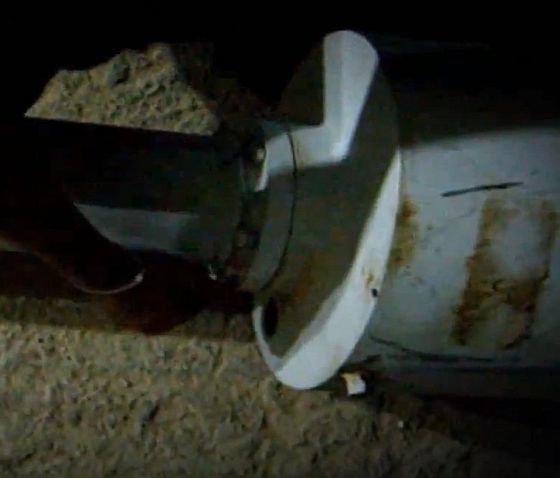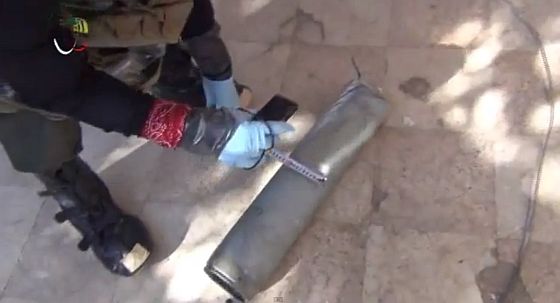Eliot Higgins has become one of the most widely respected analysts studying weapons used in Syria. At Brown Moses Blog he writes:
Since the August 21st alleged chemical attack in Damascus, I’ve been working to gather as much evidence as possible relating to the attack, and sharing it on this blog. This post acts to summarise the evidence I’ve gathered so far, as well as examining some of the claims made about the attack. This is all up for healthy debate in the comments below, and it should be kept in mind that “evidence” does not equal “proof” when debating this information.
What munitions were used in the attack?
One thing to understand about the munitions used in chemical attacks is they are designed to disperse an agent, and as chemical agents are generally heat sensitive, huge explosions are the not the ideal mechanism to do that. In many cases a smaller dispersal charge is used, and this means you can expect to find significant remains of the munitions used after a chemical attack.
M14 140mm Artillery Rocket
Since the attacks the remains of only two munitions have been recorded by activists in Damascus. The first, a M14 140mm artillery rocket fired from the BM-14 multiple rocket launcher (and variants), was filmed in Medmah al-Sham in Damascus, and footage recorded by the activists shows the UN inspectors taking measurements and samples from the munition. The remains shown in the video are barely damaged, with only the warhead and connector missing. This may be significant, as one potential warhead carries 2.2kg of sarin, but it should be clear there’s also a smoke warhead for this munition. As with both munitions linked to the alleged chemical attack, it seems only the UN report will clarify whether or not these were likely to be carrying any sort of chemical agent. Only one example of this artillery rocket was recorded and put online, it’s unknown if there’s further examples at the attack sites. More details on the M14 140mm and my identification of it can be found here.
The second munition linked to the alleged chemical attack is pictured above. What’s extremely interesting about this munition is it appears to be something that’s unique to the conflict. I’ve spoken to a number of arms and chemical weapons specialists, and they do not recognise this as any specific type of munition. For the purposes of this blog post, and to save me having to write out “the unidentified munition linked to alleged chemical attacks” repeatedly, I will refer to this as the UMLACA (Unidentified Munition Linked to Alleged Chemical Attacks). [Continue reading…]

The canister shown in the image above, appears to be of similar dimension to the head of the missile shown in the video at the top of this post. Its construction quality does not suggest that this was fabricated in some jihadist’s workshop. Moreover, the launcher shown in the video appears to be an Iranian Falaq-2 model, according to N.R. Jenzen-Jones.
For those who are still in the false flag brigade and who insist that the attack must have been launched by an opposition element — sure, that’s possible.
It’s possible that rebels were able to steal or capture an Iranian launcher. It’s possible that they were also able to obtain missiles already armed with their chemical components from one of the regime’s stockpiles. It’s possible that having gathered together the weapons and the delivery system. It’s possible that each of these came with detailed instructions on how to use them. And it’s possible that these novices in the use of such weapons were quick studies and successfully fired them.
All of that is possible. But is it likely? And given the more obvious explanation — that these chemical weapons were being used by the forces that had been trained and then authorized to use them — why lean in favor of the remote possibility?
I suspect the reason is this — and it has nothing to do with the evidence. If you start with two convictions — that military intervention in Syria is a bad idea, and that the U.S. is hellbent on intervening — then you will be vigilant, watching for anything that could be used as a pretext for intervention. If such a pretext emerges, then the first line of resistance in preventing its use as a justification for intervention will be to say: it didn’t happen. The second line of resistance is to concede it happened but to assert that the Assad regime was not responsible.
The cause is just — attempting to oppose what appears to be an unjust war-making agenda — but its pursuit gets quickly divorced from any desire to be objective. The focus is on that which must be resisted, even if that means abandoning any real interest in what actually happened.




I’m not in the false flag brigade, but with Saudi intelligence intimately involved with the rebels are there less fantastic scenarios than the one you outlined? It seems there are a lot of actors here who would stoop to any deception to realize their objectives.
What do you think about Gareth Porter’s piece at truthout?:
http://truth-out.org/news/item/18559-how-intelligence-was-twisted-to-support-an-attack-on-syria
What do I think of GP’s piece? Short answer: dishonest journalism.
It’s loaded with spurious reasoning, unsubstantiated claims, and outright deception.
Here’s an example of spurious reasoning: For an intercepted conversation between regime officials to provide evidence that the regime had used chemical weapons, then the alleged chemical weapons officer would need to have said something like: “We fired the chemical weapons.” I’d agree — if this was script for a bloody James Bond movie.
If two people have a conversation in which neither makes reference to the day of the week, are we to conclude that neither of them know the day of the week? Of course not. There are implicit elements in all conversation.
Instead of speculating about what might constitute confirmation of chemical weapons use, would it be preferable to see transcripts of the conversation in question? No doubt. But let’s not assume that they need to include any explicit reference to chemical weapons.
The intelligence summary released by the White House said this:
And the earlier reporting to which that statement seems strongly linked said this:
GP concocts this fanciful alternative explanation for the cause of the concern/panic: “that the official wanted the [UN] inspectors to be able ascertain that there was no use of chemical weapons by Syrian forces in eastern Ghouta.”
GP then follows this with outright deception — claiming that the Syrians responded promptly to a request to send in the inspectors: “the fact that the regime agreed within 24 hours of the first formal request”. He neglects to mention that two days earlier UN Secretary General Ban Ki-moon called on the Syrians to provide immediate access. I guess that call from Ki-moon wasn’t formal enough.
As for unsubstantiated claims there’s his central claim: that Israeli intelligence is being passed off as US intelligence. He treats multiple reports of intercepted conversations as necessarily being reports referring to the same conversation.
Is it conceivable that Israeli intelligence picked up one conversation and US intelligence picked up another one? The onus is on GP to demonstrate why the LA Times report he cites and the Foreign Policy report he also cites are referring to the same conversation. The LA Times, citing a German magazine, says the Israelis “eavesdropped on a conversation between senior Syrian officials about use of chemical agents.” Nothing more specific. Foreign Policy (The Cable) in the passage I’ve cited about refers to phone calls “overheard by U.S. intelligence services.”
And then we get crap links:
GP is citing a CBS report and the link goes to CBS but the report doesn’t include the quote. I checked WayBack to see if an earlier version of the report contained the quote. No luck. By this point I’m wondering: why the hell am I doing someone else’s work?
So let’s take a step back and look at these questions about the chemical attacks and apply a bit of common sense — though apparently it’s not common.
As far as I’m aware there isn’t any big discussion going on about whether chemical weapons were involved in the August 21 deaths. I know Vladamir Putin today suggested that the deaths might have been caused by “chemical pollutants” but seriously, at this point the death toll in Damascus utterly dwarfs the deaths that can thus far be attributed to the Fukushima Daiichi nuclear disaster. So the question is much less about whether chemical weapons were involved and more about who used them.
It has been undisputed for decades that the Syrian government possesses chemical weapons stockpiles. Indeed, it has generally been regarded that this is Syria’s secret “right” as a country bordering a nuclear-armed state, Israel. So even if we knew nothing else whatsoever, in the event that chemical weapons are used in Syria, the regime is the prime suspect.
It’s now two weeks after the attack which should have been an adequate amount of time for an alternative narrative to start to coalesce. That is to say, that if a narrative was plausible it would not only get repeated but it would get further reinforced by new supporting evidence and in due course this alternative narrative would start to become more plausible than the story being promoted by the US and its allies. Syria is not without its allies or sympathetic media outlets, so why has this story not emerged? Why instead has the alternative narrative really never become a narrative at all but instead simply been an endless repetition of skepticism about Assad’s responsibility?
The answer is simple: there is no compelling alternative explanation about what happened on August 21.
To get more specific, consider these two narratives. Soon after the attack there was a story appearing in the Syrian state media claiming that labs had been found in tunnels and this is where the chemicals had been released, supposedly in some kind of accident. Why did we never see videos of this? Why were the UN inspectors not taken to view this?
At the same time there were witness accounts referring to missiles landing at the site of the attacks which didn’t explode — non-exploding weapons being a signature of CW. Now those verbal accounts are backed up by photos of the missiles bent by impact but clearly not ripped apart by high explosives. And not only that — we have video showing the launch of very similar looking missiles with large canisters at the head. This is what accumulating evidence looks like. It adds detail and fills out the picture.
Let’s suppose, just for the sake of argument, that the Saudis supplied a rebel group with chemical weapons, vastly more lethal than anything in their arsenal. Why use them for a false flag operation? Why not aim them at the presidential palace?
Thanks for this painstaking (and time-consuming) analysis. More than I expected. I’ll read Gareth Porter more skeptically from now on. I still have trouble following the nuance of your position on what an appropriate U.S. response (if any) should be. For what it’s worth, I appreciate your hard work.
thanks for helping me seperate the wheat from the chaff.keep up the good work. logical rational people are a rarity in a sea of cyberbalkanization. i just hope that the un identify clearly the origin of these attacks before obama or congress do or dont do something they may regret.